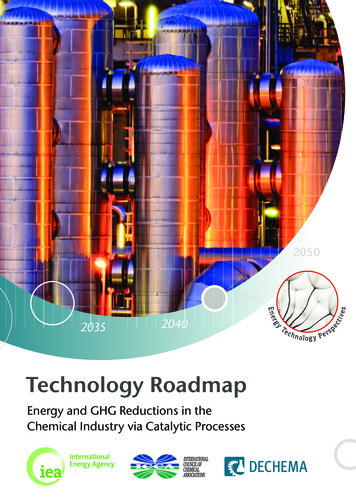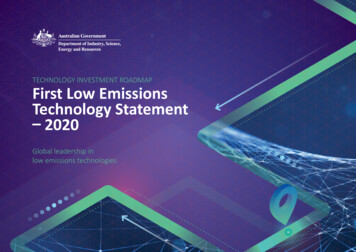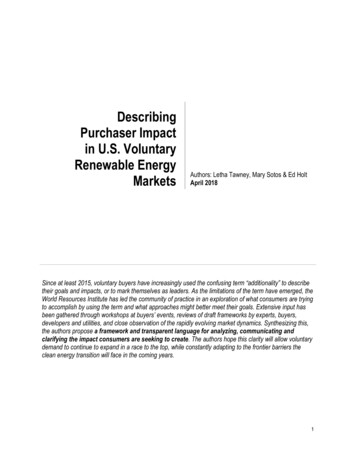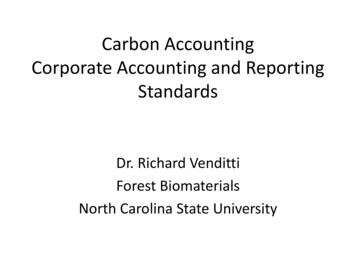
Transcription
2050Energy and GHG Reductions in theChemical Industry via Catalytic ProcessestivecTeyTechnology Roadmaprg2040Ene2035es2045chnrsolo g y P ep
INTERNATIONAL ENERGY AGENCYThe International Energy Agency (IEA), anautonomous agency, was established inNovember 1974. Its primary mandate was – andis – two-fold: to promote energy security amongstits member countries through collective responseto physical disruptions in oil supply, and provideauthoritative research and analysis on ways toensure reliable, affordable and clean energy for its28 member countries and beyond. The IEA carriesout a comprehensive programme of energy cooperation among its member countries, each ofwhich is obliged to hold oil stocks equivalent to90 days of its net imports.DECHEMA GESELLSCHAFT FÜRCHEMISCHE TECHNIK UNDBIOTECHNOLOGIE E. V.DECHEMA Gesellschaft für Chemische Technikund Biotechnologie e. V. (Society for ChemicalEngineering and Biotechnology) is a non-profitscientific and technical society based in Frankfurtam Main, Germany. It has more than 5 500 privateand institutional members, among them scientists,engineers, companies, organisations and institutes.DECHEMA aims at the promotion and support ofresearch and technological progress in ChemicalTechnology and Biotechnology. DECHEMA regardsitself as interface between science, economy, stateand public.INTERNATIONAL COUNCILOF CHEMICAL ASSOCIATIONSThe International Council of Chemical Associations(ICCA) serves as the worldwide voice of thechemical industry and promotes adoption of bestpractices such as Responsible Care across theindustry. The ICCA goals include reducing energyuse and greenhouse-gas (GHG) emissions globallyfrom production of chemicals and increasingthe positive impact of its products in reducingemissions along the value chain.Copyright 2013No reproduction, transmission or translation of this publication may be made without prior written permission.Applications should be sent to: rights@iea.org
ForewordCurrent trends in energy supply and use areunsustainable – economically, environmentally andsocially. Without decisive action, energy-relatedemissions of carbon dioxide (CO2) will more thandouble by 2050 and increased fossil energy demandwill heighten concerns over the security of supplies.We can and must change our current path, butthis will take an energy revolution and low-carbonenergy technologies will have a crucial role to play.Energy efficiency, many types of renewable energy,carbon capture and storage (CCS), nuclear powerand new transport technologies will all requirewidespread deployment if we are to reach our goalsto reduce greenhouse-gas (GHG) emissions. Everymajor country and sector of the economy must beinvolved. The task is urgent if we are to make surethat investment decisions taken now represent thelong-term optimum for energy efficiency and GHGreduction. The role of developing countries, whichare driving future growth, warrants particular focusin any future roadmap.Awareness is growing on the need to turn politicalstatements and analytical work into concrete action.To spark this movement, at the request of the G8,the International Energy Agency (IEA) is leadingthe development of a series of roadmaps for someof the most important technologies. By identifyingthe steps needed to accelerate the implementationof radical technology changes, these roadmaps willenable governments, industry and financial partnersto make the right choices. This will, in turn, helpsocieties make the right decisions.The chemical industry is a large energy user; butchemical products and technologies also are usedin a wide array of energy saving and/or renewableenergy applications so the industry has also anenergy saving role. The chemical and petrochemicalsector is by far the largest industrial energy user,accounting for roughly 10% of total worldwidefinal energy demand and 7% of global GHGemissions. The International Council of ChemicalAssociations (ICCA) has partnered with the IEAand DECHEMA (Society for Chemical Engineeringand Biotechnology) to describe the path towardfurther improvements in energy efficiency and GHGreductions in the chemical sector.This roadmap focuses on the role of catalyticprocesses in reducing energy use and GHG emissionsin the chemical sector. Around 90% of chemicalprocesses use catalysts for efficient production.Catalysis is an important source of technology-basedefficiency improvement potential; indeed, this workshows an energy savings potential approaching13 exajoules (EJ) by 2050 – equivalent to the currentannual primary energy use of Germany.Concerted, long-term action by all stakeholdersis critical to realising the vision and impactsdescribed in this roadmap. Governments can helpcreate a favourable environment that encouragesadditional gains in energy efficiency and lowersenergy-related emissions. Industry can provide thefocus on top opportunities, highlight priorities forsupport, accelerate both capital investments andresearch and development (R&D), and promptfurther focused collaborations with academia andresearch institutions on these industrially relevantchallenges. We hope this roadmap encouragesboth governments and industry to take these steps,working together to achieve these goals.Maria van der HoevenExecutive DirectorInternational Energy Agency (IEA)Yoshimitsu KobayashiCEO sponsor of Energy and Climate Change,International Council of Chemical Associations (ICCA)Rainer DiercksChairman DECHEMA BoardThis report is the result of a collaborative effort between the IEA, its member countries, and various consultants and expertsworldwide. Users of this report shall make their own independent business decisions at their own risk and, in particular,without undue reliance on this report. Nothing in this report shall constitute professional advice, and no representationor warranty, express or implied, is made in respect of the completeness or accuracy of the contents of this report. The IEA,ICCA and DECHEMA accepts no liability whatsoever for any direct or indirect damages resulting from any use of this reportor its contents. A wide range of experts reviewed drafts. However, the views expressed do not necessarily represent theviews or policy of the IEA or its individual member countries.Foreword1
Table of contentsForeword1Acknowledgements4Key findings5Key actions in the next ten years5Introduction6Status of current energy use and GHG emissions12Technology opportunities17Incremental improvements19Deployment of best practice technologies19Emerging technologies20Game changers22Technology actions and milestones29Vision for advances in catalytic and related process improvements for the chemicals industry 31IEA scenarios: catalysis and beyond.32DECHEMA scenarios36Resource needs40Other catalytic process-related areas42Avoided emissions in the use phase44Policy, finance and international collaboration: actions and milestones46Policy support for research and development46Securing financing, including through timely incentives47Policies to promote international collaboration and sharing of data, information, best practice and R&D47Policies for regulation48Stakeholder collaboration, including public-private partnerships48Conclusion: near-term actions for stakeholders50Annexes51Glossary52References55List of figuresFigure 1. Comparison of approach, boundaries and process coverage of IEA and DECHEMA modelsFigure 2. Global energy consumption versus production volumes of top 18 large-volume chemicals, 201013Figure 3. Global GHG emissions versus production volumes of top 18 large-volume chemicals, 201014Figure 4. Ammonia synthesis: a simplified schematic14Figure 5. Ammonia synthesis breakthrough and energy efficiency16Figure 6. Evolution of energy intensity for incremental improvements and deployment of BPTs17Figure 7.18Energy impact of improvement options for the top 18 chemical products to 2050Figure 8. GHG impact of improvement options for the top 18 chemical products to 205029Technology Roadmap18Energy and GHG reductions in the chemical industry via catalytic processes
Figure 9. Process steps involved in hydrogen from the water cleavage option23Figure 10. Additional energy demand versus fossil energy savings for replacement of current ammoniaand methanol processes by hydrogen-based routes24Figure 11. GHG savings enabled by production of hydrogen-based ammonia and methanol25Figure 12. Energy use for biomass versus fossil routes to HVC, including the total process chain26Figure 13. Biomass based versus fossil energy use of the routes compared in Figure 1227Figure 14. Impact of biomass-to-olefin routes on energy consumption of the chemical industry27Figure 15. GHG emissions for biomass versus fossil routes to HVC, including total process chain28Figure 16. Forecast of chemical production volumes between 2010 and 205031Figure 17. Current energy savings potential for chemicals and petrochemicals, based on BPT deployment33Figure 18. Potential impact of technologies to reduce direct CO2 emissions, 2DS versus 6DS34Figure 19. Energy savings by region in the Low-Demand Case36Figure 20. Energy savings potential of catalyst and related process advances from all categories37Figure 21. GHG emissions avoidance potential of catalyst and related process advances fromall categories compared to BAU37Figure 22. Regional impact of incremental, BPT optimistic and emerging technologiesDECHEMA scenarios compared to BAU38Figure 23. Energy consumption by scenario for four different world regions39Figure 24. Potential GHG use-phase impact, using BAU direct emissions impact from this workand the McKinsey impact ratio of 2.1 t of GHGs saved/ tproduction44Figure 25. Collaborators with closest ties to catalysis and related processes development49List of tablesTable 1.Summary of assumptions for BPT deployment scenarios in the chemical industry19Table 2.Summary of potential catalyst impact on energy and GHG in chemical product-type scenarios20Table 3.Top catalyst/process development opportunities and technology needs29Table 4.Milestones for technology improvements for top processes30Table 5.Energy savings and emissions reduction projected in 2050 by the two models32Table 6.High-value chemicals, ammonia and methanol production by scenario, 2050 (Mt)34Table 7.Key hurdles46List of boxesBox 1.Catalysts in the chemical industry: a target for transformation7Box 2.IEA Energy Technology Perspectives 2DS10Box 3.DECHEMA scenarios11Box 4.Historic example: Haber-Bosch changed the game for ammonia synthesis15Box 5.Gas-to-liquid from shale gas22Box 6.IEA Low- and High-Demand Cases for chemicals33Box 7.Carbon capture and storage (CCS)35Table of contents3
AcknowledgementsThis Roadmap gathers input from multiple sources;thus, the authors would like to thank those whocontributed generously of their expertise, experienceand viewpoints. The early input of catalyst expertsfrom companies and academia, who respondedto the questionnaires, provided a solid foundationwith real industrial input and thanks to those whocontributed is warranted.The authors were fortunate to have the input of19 experts from industry and non-governmentalorganisations (NGOs) at the Catalyst ExpertsWorkshop (7 to 9 September 2011, Paris). Several ofthese experts continued to provide advice and helpin tracking down information during the generationof this roadmap, which is greatly appreciated. The listof participants for this and other workshops can befound in Annex 11.1Several policy makers graciously gave early inputon the catalyst roadmap at the Policy Workshop(23 January 2012, Brussels). This helped tounderstand the current improvement efforts andleverage opportunities in other industries, thecontext of support and the need for finance options/framework. It was also an occasion to have a frankdiscussion on realistic routes and targets to energyand GHG reductions.At a third event, the Chemical Sector EnergyEfficiency Improvements: Technology Roadmapand Policy Options Workshop (8 May 2012, Beijing),the work benefitted from the input of more than120 participants. We would like to thank our coorganisers China Petroleum and Chemical IndustryFederation (CPCIF), the Association of InternationalChemical Manufactures (AICM) and the ChinaBusiness Council for Sustainable Development(CBCSD) for their numerous contributions andcollaboration.Several Licensors provided input and we wouldespecially like to thank Bernd Langanke andcolleagues at Uhde and Florian Pontzen at Air Liquidefor their helpful input and comments. Russel Heinenat SRI (now IHS) provided invaluable input; we thankhim and his colleagues for the fruitful discussions andmany data inputs. We would like to thank contactsat member associations for their input, especiallythe American Chemistry Council (ACC), the ConseilEuropéen de l’Industrie Chimique (CEFIC) and theJapanese Chemical Industry Association (JCIA). KevinSwift (ACC) and Moncef Hadhri (CEFIC) in particularprovided useful information on economic impactand energy intensity history. Several colleagues ofCore Team members (see below) provided input,early reviews and considerable help in organising theworkshops. Again, we would like to thank them fortheir generous contributions.Several other IEA staff members providedthoughtful comments and support includingAraceli Fernandez Pales, Laszlo Varro and formerIEA colleague Jayen Veerapen. The authors wouldalso like to thank Marilyn Smith for editing themanuscript, Annette Hardcastle who helped preparethe manuscript, as well as the IEA Publication Unit,in particular Muriel Custodio, Astrid Dumond,Rebecca Gaghen, Cheryl Haines and Bertrand Sadinfor their assistance in additional editing, layoutand production.1. E xtensive annexes to this roadmap are available online rialcatalysisFinally, many thanks to the Core Team for theirleadership, dedication, and persistence:Florian Ausfelder, DECHEMARussel Mills*, Dow ChemicalAlexis Bazzanella, DECHEMAEd Rightor*, Dow ChemicalHans VanBrackle, ExxonMobilCecilia Tam, IEARegina Wilde*, BASFClaus Beckmann* BASFNathalie Trudeau, IEAPeter Botschek, CEFIC* Co-chair4Technology RoadmapEnergy and GHG reductions in the chemical industry via catalytic processes
Key findingszz The manufacture of 18 products (amongthousands) from the chemical industry account for80% of energy demand in the chemical industryand 75% of greenhouse gas (GHG) emissions.zz Catalyst and related process improvements couldreduce energy intensity2 for these products by20% to 40% as a whole by 2050 combining allscenarios. In absolute terms, such improvementscould save as much as 13 exajoules (EJ) and1 gigatonne (Gt) of carbon dioxide equivalent(CO2-eq) per year by 2050 versus a “business-asusual” scenario.3zz In the short to medium term (to 2025),steady progress in implementing incrementalimprovements and deploying best practicetechnologies (BPT) could provide substantialenergy savings and emissions reductionscompared to business as usual.zz Achieving deeper energy and emissions cutswill require development and deployment ofemerging technologies that exceed the capacityof current BPTs.zz A step change in the sector’s energy consumptionand GHG emissions would require thedevelopment of “game changer” technologies,such as sustainable biomass feedstocks andhydrogen from renewable energy sources whichhave not yet reached commercial maturity.zz Therefore, long-term investment and supportfor research and development (R&D) to enableinnovation is warranted to continue advances innew technologies.Key actionsin the next ten yearszz Create a long-term policy framework thatencourages investments to reinvigorate catalyst/process improvement and R&D for high-energyconsuming processes.zz Introduce enabling policies for best practices inregions where new facilities are built, especially indeveloping countries.zz Eliminate energy subsidies that are barriers to theuse of more energy efficient technology. In thecase of BPTs, policy measures may be neededto overcome barriers to deployment, includinghigh capital costs, replacement challenges andcompeting investments.Chemical industryzz Identify top catalyst/process-relatedopportunities; accelerate R&D and capitalinvestments that improve energy efficiency.zz Facilitate R&D on game changers with partners tolower barriers and operating costs.zz Promote global and regional co-operation onreducing energy and/or emissions via industryassociations.Academia and research organisationszz Undertake or stimulate academic and nationallaboratory research on large-volume/high-energyuse processes.zz Take action with industry leaders to identify topprospects for reducing technical barriers.Financial institutionszz Work together with the chemical industryto better understand changes in fundingrequirements of a low-carbon chemical sectorand funding opportunities of such a transition.Getting onto the right path to achieve the goalsof this roadmap requires immediate effort by allstakeholders, both individually and jointly, todevelop long-term strategies and correspondingmechanisms to prompt action and measureprogress.Policymakerszz Develop and implement policies that more highlyreward energy efficiency investments and removebarriers for new investments.2. Energy used per unit of product produced.3. A n exajoule is 1018 joules. In 2010, the United States used 93 EJ ofprimary energy and Germany 13.7 EJ.Key findings5
IntroductionMore than 95% of all manufactured products relyon chemistry (ICCA, 2010). Chemistry providessolutions in areas as diverse as alternative energy,transportation, communications, buildings,pharmaceuticals and information technology.Output from the chemical industry covers threewide ranges of products: base chemicals, specialitychemicals and consumer chemicals. These threeproduct ranges provide benefits to consumers anda multitude of industries, including a strategic rolein the generation, usage and storage of energy. Thechemical sector is an enabler for growth in the globaleconomy and development in emerging countries.With global sales of USD 3 trillion and over sevenmillion people employed in 2010, the chemicalindustry is one of the largest in the world. Notsurprisingly, the chemical industry is also a largeenergy consumer. Around 90% of chemical processesinvolve the use of catalysts – i.e. added substancesthat increase the rate of reaction generally withoutbeing consumed by it – and related processes toenhance production efficiency and reduce energyuse, thereby curtailing GHG emission levels.In the face of sustainability concerns, rising energycosts and competitive pressures, this roadmap forthe chemical and petrochemical industry (hereafterreferred to as “the chemical industry”) investigateshow advances in catalytic processes can contributeto further increasing the sector’s efficient use ofenergy and reducing emissions of GHGs.At present, global energy demand for the chemicalindustry is 15 EJ per year (EJ/yr) excluding feedstock;including feedstock, the industry uses 42 EJ/yrand accounts for approximately 10% of the globalenergy demand or 30% of the total industrial energydemand worldwide (IEA, 2012). Furthermore, thechemical industry generates 5.5% of CO2 emissions(7% of global GHG emissions) and is responsiblefor 17% of industrial CO2 emissions (20% of theindustrial GHG emissions). Energy consumption andGHG emissions associated with the manufactureof products are a major focus. In 2005, globalGHG emissions across the chemical industry were3.3 GtCO2-eq ( /- 25%), with 2.1 Gt from themanufacture of products and 1.2 Gt from extractionof feedstock/fuel and disposal phases (ICCA, 2009).Despite these negative impacts, widespread use ofmany products (e.g. insulation, efficient lighting,lighter materials for automobiles and advancedmaterials for renewable technologies) has alreadymade substantial contributions to reducing energydemand and emissions across many sectors. A study6Technology Roadmapcompiling several life-cycle analyses (LCAs) showedthat for every unit of carbon it emitted in 2005,the industry’s products and technologies enabled2.1 units to 2.6 units of CO2-eq savings (compared tonon-chemical alternatives) (ICCA, 2009).The industry has a long history of reducing energyconsumption and emissions while also providinginnovative solutions. Since 1974, the chemicalindustry in the United States has improved itsenergy intensity (energy consumption per unit ofproduction) by 50%; since 1990, the absolute level ofGHG emissions has decreased by 13% (ACC, 2012).In Europe, energy intensity in 2010 in the chemicalindustry was 53.4 % lower than in 1990 (CEFIC, 2012).While the sector is energy-intense, its very scopeand scale (including in many cases large-scaleproduction facilities) suggests that small changes inenergy consumption and GHG emissions associatedwith particular chemical processes can havesubstantial impacts.When investigating ways to reduce both energyconsumption and emissions in the industry,stakeholders identified one area of significantpotential: catalytic process advances, whichrefers to efforts to stimulate the chemical reactionsacross the full production chain of a given productsuch that the desired result is achieved with lowerenergy inputs and fewer GHG emissions (Box 1). Thisroadmap focuses on this substantial potential. Giventhe complexity of the industry, the roadmap willexamine both a target-driven approach (based on theIEA model) and one that reflects expected evolutionof industry from the technology perspective (theDECHEMA model), under different scenarios.While catalysts play a vital role in chemical processes,they are not an isolated technology, as is the casefor many technologies within other IEA technologyroadmaps. Where a new catalyst is used to improveenergy efficiency and reduce GHG emissions, it isusually not implemented in an isolated manner, butis combined with corresponding process technologyadvances, such as a new reactor design. Moreover,large-volume processes tend to be highly integrated,making it difficult to pinpoint the impact of thecatalyst/catalytic step(s) on the energy use andemissions of the entire process. For this reason, theroadmap makes no attempt to separate the catalysisimpact on specific units in a specific process chain.Instead, the roadmap considers the improvementin specific energy consumption (SEC) for theprocess enabled by catalyst improvement and thesubsequent improvements in associated steps.Energy and GHG reductions in the chemical industry via catalytic processes
Box 1: Catalysts in the chemical industry: a target for transformationThe Chinese character for catalyst is the sameas that for “marriage broker”; this is an aptdescription of the function a catalyst assumesfor the partners in a reaction.The input of a substance called a catalyst,stimulates an increase in the rate of a chemicalreaction – usually by facilitating an alternativereaction pathway with lower activation energy.Unlike other reagents that participate in areaction, catalysts are generally not consumedin the process. In some cases, they mayparticipate in multiple reactions.Catalysts steer chemical reactions towardsa specific outcome and generally allow foreasier-to-control process conditions, such aslower temperatures and pressures or increasedyield. They are essential to efficient productionacross many industrial sectors: some 90%of chemical processes employ catalysts, asdo nearly all petroleum refining processes(Yoneyama, 2010).The global market for catalysts within thesesectors was expected to reach USD 16.3 billionin 2012 (Freedonia Research), with those usedin chemical processing accounting for about75% of the market and those for petroleumrefining the other 25%.Objectives and scopeTo investigate the degree to which improved catalyticprocesses might reduce energy consumptionand GHG emissions in the chemical industry, apartnership was formed between the IEA, the ICCAand DECHEMA to develop a roadmap that would:zz provide credible information on the potential toreduce energy consumption and GHG emissionsthrough improved catalytic processes;zz identify process-related technologyimprovements and breakthroughs, as well as thepaths to achieve them;zz identify hurdles and means to lower or overcomethem;zz provide responsible advice for policy makers andindustry on how to enable the desired results.But the value of catalysis extends beyondchemical or refinery processes. Catalysts areused in many other industrial applications, e.g.for reducing emission of air pollutants fromflue gas at power or other industrial plants.Moreover, catalysis underpins equipmentand products used in daily life in a variety ofapplications such as catalytic converters incars, self-cleaning surfaces, indoor air controland laundry detergents that are effective incolder water.Catalysts can be either compounds dissolvedin the reaction mixture (homogenouscatalysis) or solids dispersed in the reactionmixture or provided on the reactor walls asa coating (heterogeneous catalysis). The useof enzymes for chemical transformations isreferred to as biocatalysis.Not all applications of catalysis target energysavings or GHG reductions, and some have onlyindirect impacts on these criteria. This roadmapfocuses primarily on areas with the most directenergy and GHG impact for the chemicalsector, but of course other areas have potentialfor improved catalysis and additional impact.This roadmap provides a quantitative assessment ofthe main catalytic processes in the chemical sectorand their impact on the top (i.e. largest volume)18 chemical products. It also describes some impactson other catalytic processes using rough estimatesbased on publicly available information. The impactof a small number of in-use products is highlightedqualitatively or using illustrative examples.ApproachTwo key challenges arise when attempting toidentify opportunities to reduce future energyconsumption and GHG emissions in the chemicalindustry. First, many chemical products are notproduced by a single production process, butby a number of different processes that employdifferent reaction pathways (catalytic and noncatalytic). Often, the production process alsoIntroduction7
requires a combination of technologies, some ofwhich may be integral to a catalytic process. Thus,it is difficult to quantify precisely the degree towhich a single reaction or technology contributesto improved efficiency, or at which stage. Thesecond challenge is that the industry is constantlyevolving, often with the aim of improvingefficiency. Historically, small improvements wereachieved on a regular basis; because of the scale ofthe industry, some have had substantial impacts.Other reaction or technology improvementsare more significant and, on occasion, a radicalbreakthrough in the catalyst or the technologyoccurs that essentially “changes the game”.This roadmap examines two approaches forprojecting into the future: both use modellingtechnologies and are based on current knowledge.Both models use the same data on currentproduction volumes as well as on current levelsof energy consumption and CO2 emissions for theproducts analysed. But the IEA and DECHEMAmodelling exercises follow different approaches toproject the future impact, and use available dataand information in two different ways.zz T he IEA model is target-oriented, followingthe approach used for its publication EnergyTechnology Perspectives 2012 (ETP 2012), whichaims to achieve a global scenario in whichaverage temperature increase is limited to2 C. Globally, this requires a 50% reduction inenergy-related CO2 emissions across the energysector in 2050 compared to 2009 levels. TheIEA model assesses the current share of thechemical industry in global energy demand andemissions, and explores the technology pathwayrequired to achieve the level of reductionneeded such that the industry as a whole makesits fair contribution to the global goal. As in itsmodelling of other sectors, the ETP approachconsiders a wide range of technologies thatcan influence a given sector. In the case of thechemical industry, technologies consideredinclude deploying BPTs, improving membranesand separation processes, using bio-based fuelsand integrating carbon capture and storage(CCS) facilities in chemical plants. The IEAthen considers how policy can stimulate thenecessary action on the part of all industrystakeholders.zz The DECHEMA approach is more reflectiveof the industry perspective of identifyingopportunities to improve specific processes to8Technology Roadmapreduce the energy and emissions impacts ofindividual chemical products. Thus, the startingpoint for the DECHEMA scenarios is the analysisof “energetics”, which concerns the gap betweenwhat is “theoretically optimal” in a particularprocess and current realities. To a large degree,the DECHEMA model extends past trends into thefuture, acknowledging that the combination ofcatalysts and technological advances will deliverfour types of progress, each with greater capacityto close the gap: incremental improvements, BPT,emerging technologies and game changers.This model identifies the largest gaps, whichreflect the best opportunities for radicalimprovement (game changers). But it alsoacknowledges that closing such gaps typicallyrequires years of R&D, and substantial financialinvestment. At the other extreme – i.e. whereprocesses are already close to the theoreticallimits for efficiency and emissions reduction –future advances are likely limited to incrementalimprovements. In this case, it becomes morevalid to ask “How much gain, at what cost?”A challenge inherent within the industryperspective is that energy efficiency and – withthe introduction of carbon markets – emissionsreduction have a monetary value that not onlycontributes to proj
Current energy savings potential for chemicals and petrochemicals, based on BPT deployment 33 Figure 18. Potential impact of technologies to reduce direct CO 2 emissions, 2DS versus 6DS 34 Figure 19. Energy savings by region in the Low-Demand Case 36 Figure 20. Energy savings potential of catalyst and related process advances from all categories 37










